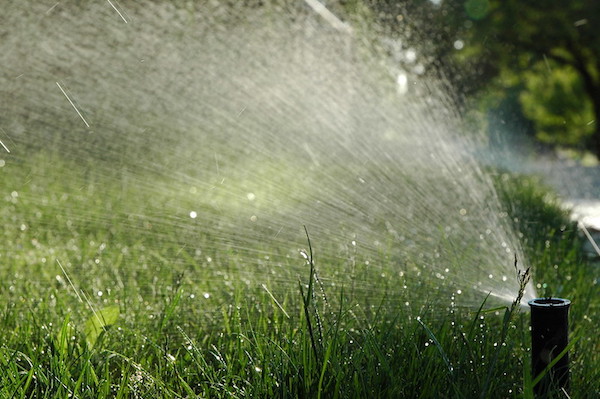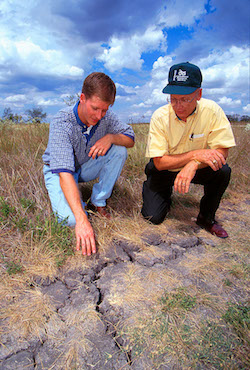SEJournal Online is the digital news magazine of the Society of Environmental Journalists. Learn more about SEJournal Online, including submission, subscription and advertising information.
 |
| An automatic sprinkler irrigates an urban lawn. In many parts of the country, Americans use more water than nature resupplies. Photo: UBC Geography/A. Christen via Flickr Creative Commons (CC BY 2.0). |
Feature: Water-Sharing in the West — An Urgent and Complicated Environmental Story
By Jennifer Oldham
There is a disconnect in the West between communities centered around sprawling golf courses, grass-covered medians and homes with expansive lawns, and a 19th-century water distribution system buckling under the worst drought in 1,200 years.
The region’s population is growing faster than the rest of the country’s and tapping into rivers and reservoirs that are at historic lows. Yet residents expect water to come out of the faucet every time they turn it on.
The ways in which residential, agricultural,
municipal, industrial and other users
share water are no longer working.
The ways in which residential, agricultural, municipal, industrial and other users share water are no longer working. Shortages are becoming more prevalent — forcing some municipalities to suspend construction. Massive planned communities are stalled (may require subscription) because developers cannot prove to regulators they can provide a sustainable water supply.
The outdated water distribution system is also imperiling world-renowned ecosystems, such as those at Great Sand Dunes National Park and Baca National Wildlife Refuge, both in Colorado.
With climate change accelerating this water crisis, it is likely to be one of the most urgent stories for environmental journalists to investigate as this decade progresses.
I explored it in a recent investigation for Civil Eats, zeroing in on the commodification of water rights in Colorado. The piece poses a question: Should we be treating water as a public resource or an investment tool?
Crisis mitigation or profiteering?
Private investors have already decided: They are buying up water rights in a bet on escalating prices resulting from the prolonged drought.
These firms, eager to act as middlemen between farmers and water providers, say treating water as a commodity could help mitigate future water crises.
Now, water trades on the Chicago Mercantile Exchange. A company led by a former Colorado governor and a group of well-to-do businessmen, Renewable Water Resources, aims to pipe water from a ranch it owns in a high desert valley and pump it 200 miles north to a fast-growing Denver suburb. And a New York-based hedge fund, Water Asset Management, is positioned to harvest water by fallowing farmland on properties it owns on Colorado’s western slope.
Such acquisitions drew the attention of California state legislators, who asked Attorney General Merrick Garland “to investigate anti-competitive practices in water rights purchasing and potential drought profiteering in western states.”
The inability of the public to easily see who owns water rights makes many nervous about unknown impacts for ratepayers and the environment.
And these concerns are not limited to the American West. The United Nations has warned that futures markets elsewhere could exacerbate inequity while speculators drive up the value of water.
Peering into murky waters
At the heart of the water commodification trend in the western United States is the fact that there’s more demand than supply. It’s important to outline this dilemma in any water story.
Mapping for your audience where their water comes from and who they share it with is crucial for them to understand the roots of any region’s worsening supply challenges. Yet parsing water rights is complicated.
Historically, utilities or municipalities have purchased water from farmers and ranchers to serve residential and business customers. Those farmers and ranchers hold some of the most senior water rights and, in most states, consume up to 80% of available water.;
The system is opaque, with speculators purchasing
water rights and holding them without a record of
transactions. There isn’t a way to track these deals.
The West’s water distribution system is largely based on a first-come, first-served arrangement known as “first in time, first in right.” But ultimately over the last 150 years, regulators distributed rights to far more water than exists. The system is opaque, with speculators purchasing water rights and holding them without a record of transactions. There isn’t a way to track these deals.
Attorneys who specialize in water law can explain how different states’ water appropriation rules work and lay out how the resource is allocated in water court. Eminent water attorneys often serve on the advisory councils, or boards, of local universities.
It’s also important for your audience to understand interstate water compacts, which divvy up water rights to particular bodies of water to participating states, and transbasin diversions, in which water is sent from one region to another through pipelines.
Supply-side issues
In my Civil Eats piece, I investigated a high alpine valley’s complex water system. Colorado’s state climatologist helped me understand how climate change influences the snowmelt and rainfall this area relies on to irrigate crops.
 |
| Two agricultural engineers inspect soil cracks caused by severe drought, to determine the effects on crop production. Photo: Scott Bauer, USDA Agricultural Research Service. |
State climatologists often understand the intricacies of how climate change is impacting stream flows in different river basins and can help pull up historic data from complicated federal databases to illustrate changing trends. They can also explain how many of these models need updating because they’re based on data that’s no longer germane, given the impacts of global warming.
To find other researchers in your region who study the impacts of climate change on water resources, tap into the network of 54 Water Resources Research Institutes.
The Bureau of Reclamation, the nation’s largest water wholesaler, can also provide information.
These experts can tie together weather-related trends, discuss how they impact supply and provide supporting data, as well as refer you to others who study specific water supply issues.
They also often partner with state and federal water managers who decide how water will be divided up among competing interests.
Water managers at the state and federal levels, including state water engineers, can explain how regional stream systems feed into rivers that multiple states rely on.
Many states also compile a water plan that explains how water is shared among residents, using scientific data to factor in climate change’s impact on supply.
In Colorado, the plan also outlines projects to buttress supply in various river basins. In addition to these surface water supplies, communities in the state are also heavily reliant on a system of aquifers. Many of these groundwater systems are shrinking faster than they’re being replenished.
Explaining how groundwater and surface water distribution systems work together to satisfy the water demands of various users is crucial to help your audience understand what needs to be done to modify this complex network as supply shrinks.
Understanding evolving demand
The demand side of the water equation is just as complicated as the supply side.
Americans use more water than nature resupplies in many areas, leading 40 states to project shortages.
Water utilities that provide water to communities can discuss evolving demand, as can water conservancy districts.
Municipalities, as well as developers who design planned communities, also understand their water needs and can point reporters to studies that show current and projected demand.
But whether we’re talking about demand or supply, the status of water as either public or private is increasingly central to the discussion.
The trend toward commoditizing water merits continued interest from journalists, particularly as climate change causes runoff and stream flow to become more variable and less predictable.
In a warmer future, “Water managers will be at the whim of individual precipitation events,” said Will Wieder, a scientist with the National Center for Atmospheric Research and co-author of a recently released water resource study. “Water management systems in snow-dominated regions are based on the predictability of snowpack and runoff, and much of that predictability could go away with climate change.”
Jennifer Oldham is a Pulitzer Prize-winning journalist who specializes in covering economic inequality, energy, the environment, politics and policy. Her work has appeared in National Geographic, Politico Magazine, ProPublica, The Washington Post and Reveal at The Center for Investigative Reporting, among others. She was previously a national correspondent at Bloomberg News and a staff writer at the Los Angeles Times.
[Editor’s Note: For more on water and drought, see a Feature on covering drought as a local story, a TipSheet on using irrigation districts to report on drought, an Issue Backgrounder on drought’s role in national security concerns, a Reporter’s Toolbox on drought-related data and a BookShelf review on the recent volume, “Water Always Wins.” You can also find drought-related news in our Water and Oceans headlines index.]
* From the weekly news magazine SEJournal Online, Vol. 8, No. 2. Content from each new issue of SEJournal Online is available to the public via the SEJournal Online main page. Subscribe to the e-newsletter here. And see past issues of the SEJournal archived here.













 Advertisement
Advertisement 



